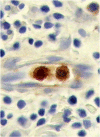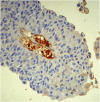Fetal haemopoiesis marking low-grade urinary bladder cancer
- PMID: 22735903
- PMCID: PMC3405209
- DOI: 10.1038/bjc.2012.268
Fetal haemopoiesis marking low-grade urinary bladder cancer
Abstract
Background: The immunohistochemical features of fetal haemoglobin cells and their distribution patterns in solid tumours, such as colorectal cancer and blastomas, suggest that fetal haemopoiesis may take place in these tumour tissues. These locally highly concentrated fetal haemoglobin (HbF) cells may promote tumour growth by providing a more efficient oxygen supply.
Methods and results: Biomarkers of HbF were checked in transitional cell carcinoma (TCC) of the urinary bladder, assessing this as a new parameter for disease management. Fetal haemoglobin was immunohistochemically examined in tumours from 60 patients with TCC of the bladder. Fetal haemoglobin erythrocytes and erythroblasts were mainly clonally distributed in proliferating blood vessels and not mixed with normal haemoglobin erythrocytes. The proportion of such HbF blood vessels could reach more than half of the total number of vessels. There were often many HbF erythroblasts distributed in one-cell or two-cell capillaries and present as 5-15% of cells in multi-cell vessels. This suggests a local proliferation of HbF-cell progenitors. Fetal haemoglobin cells were prominently marking lower grades of tumours, as 76% (n=21) of the patients with G1pTa were HbF+, whereas only 6.7% (n=30) of the patients with G3pT1-pT2a were HbF+.
Conclusion: Our results suggest that HbF, besides being a potential new marker for early tumour detection, might be an essential factor of early tumour development, as in fetal life. Inhibiting HbF upregulation may provide a therapeutic target for the inhibition of tumour growth.
© 2012 Cancer Research UK
Conflict of interest statement
The authors declare no conflict of interest.
Figures





Similar articles
-
Development of fetal haemoglobin-blood cells (F cells) within colorectal tumour tissues.J Clin Pathol. 2006 Jun;59(6):598-602. doi: 10.1136/jcp.2005.029934. Epub 2006 Feb 9. J Clin Pathol. 2006. PMID: 16469830 Free PMC article.
-
Foetal haemoglobin-blood cells (F-cells) as a feature of embryonic tumours (blastomas).Br J Cancer. 2007 Aug 6;97(3):412-9. doi: 10.1038/sj.bjc.6603867. Epub 2007 Jun 26. Br J Cancer. 2007. PMID: 17595660 Free PMC article.
-
Blood cells with fetal haemoglobin (F-cells) detected by immunohistochemistry as indicators of solid tumours.J Clin Pathol. 2004 Jul;57(7):740-5. doi: 10.1136/jcp.2003.013938. J Clin Pathol. 2004. PMID: 15220368 Free PMC article.
-
Fetal hemoglobin in sickle cell anemia.Blood. 2011 Jul 7;118(1):19-27. doi: 10.1182/blood-2011-03-325258. Epub 2011 Apr 13. Blood. 2011. PMID: 21490337 Free PMC article. Review.
-
Blood group antigens in transitional cell tumours of the urinary bladder. An immunohistochemical study.Dan Med Bull. 1994 Feb;41(1):1-11. Dan Med Bull. 1994. PMID: 8187557 Review.
Cited by
-
Revisiting Cancer Stem Cells as the Origin of Cancer-Associated Cells in the Tumor Microenvironment: A Hypothetical View from the Potential of iPSCs.Cancers (Basel). 2020 Apr 4;12(4):879. doi: 10.3390/cancers12040879. Cancers (Basel). 2020. PMID: 32260363 Free PMC article. Review.
-
ARHGAP18 is a novel gene under positive natural selection that influences HbF levels in β-thalassaemia.Mol Genet Genomics. 2018 Feb;293(1):207-216. doi: 10.1007/s00438-017-1377-2. Epub 2017 Oct 5. Mol Genet Genomics. 2018. PMID: 28983712
-
Blood and Cancer: Cancer Stem Cells as Origin of Hematopoietic Cells in Solid Tumor Microenvironments.Cells. 2020 May 22;9(5):1293. doi: 10.3390/cells9051293. Cells. 2020. PMID: 32455995 Free PMC article. Review.
-
Allelic expression patterns of imprinted and non-imprinted genes in cancer cell lines from multiple histologies.Clin Epigenetics. 2025 May 25;17(1):83. doi: 10.1186/s13148-025-01883-3. Clin Epigenetics. 2025. PMID: 40414875 Free PMC article.
References
-
- Bhnu NV, Trice TA, Lee YT, Miller JL (2004) A signaling mechanism for growth-related expression of fetal hemoglobin. Blood 103: 1929–1933 - PubMed
-
- Carlson BM (1988) The development of the circulatory system. In Patten's Foundations of Embryology, Dolinger E, Maisel J (eds). pp 594. McGraw-Hill: New York
-
- Fyrberg A, Peterson C, Kagedal B, Lotfi K (2011) Induction of fetal hemoglobin and ABCB1 gene exspression in 9-β-D-arabinofuranosylguanine-resistant MOLT-4 cells. Cancer Chemother Pharmacol 68: 583–591 - PubMed
-
- Gabbianelli M, Testa U, Morsilli O, Pelosi E, Saulle E, Petrucci E, Casteli G, Giovinazzi S, Mariani G, Fiori ME, Bonanno G, Massa A, Corce CM, Fontana L, Peschele C (2010) Mechanism of human Hb switching: a possible role of the kit receptor/miR 221-222 complex. Haematologica 95: 1253–1260 - PMC - PubMed
MeSH terms
Substances
LinkOut - more resources
Full Text Sources
Medical

